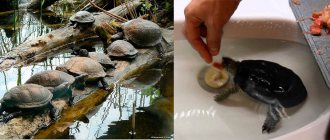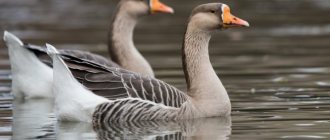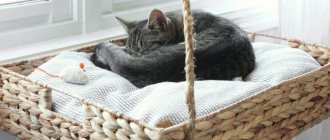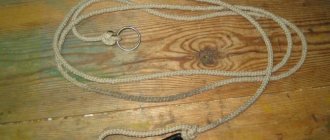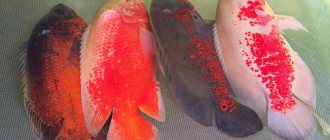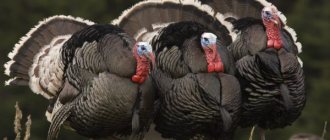Raising ducks is a very profitable business. In a year, more than a hundred eggs and about fifty ducklings can be obtained from just one individual.
Ducks are also bred for meat. Already one month old individuals of some breeds reach a weight of up to 2.5 kg, and, for example, an adult drake weighs up to 6 kg. Duck droppings are an excellent fertilizer for the garden, and bird fluff is ideal for sewing down and feather products.
That is why experienced poultry farmers recommend that anyone who is thinking about raising poultry start raising ducks. They do not require long walks, and can be kept even in a small area.
Thus, on a site with an area of 60 m2 to 70 m2, up to 150 individuals can be raised. Birds reproduce quickly, hatch their offspring well and gain weight at an accelerated pace.
But, in order to get the maximum benefit from raising this bird, you need to know the features and subtleties of keeping and breeding ducks.
Creation of a poultry house
Although ducks can easily survive changes in humidity and low sub-zero temperatures, it is still impossible to raise and breed them completely in the open air. Ducks will need their own house, a place to walk, and preferably a place to swim.
The art of raising ducks for beginners begins with creating a place for them to live. For this you will need:
- Poultry house or small house made of wood, brick or aerated concrete. The house should not have drafts. The area of the poultry house is calculated according to the principle - per 1 sq. There should be 2-3 ducks per meter, no more.
- Ducks get along well with geese and chickens, so they can be kept together. However, if there are more than 7 ducks, it will be necessary to build a separate house for them.
- The poultry house is located on the south side of the site on a hill.
- The floor of the poultry house must be insulated and raised, since the ducks sit below. If there are drafts, they will quickly catch a cold and die.
- The walls of the house must be treated with slaked lime. This will ensure optimal disinfection.
- In addition to the house, the ducks need to be provided with a spacious enclosure of 3 square meters. meters for 2 ducks.
- Ducks need access to water. This could be a pond on the site or a small reservoir on the territory of the enclosure. It is possible to keep ducks without a pond, but this way they will gain weight more slowly and lay eggs less often.
Feeders must be installed in the outdoor enclosure. Food containers should be made of metal and have good depth. It is advisable to install drinking bowls both in the outdoor and indoor enclosures. This is due to the fact that birds need a lot of water.
Disease Prevention
Despite the fact that domestic ducks practically do not get sick, it is better to play it safe and take preventive measures, especially since it is generally painless and inexpensive. To do this you need:
- ventilate the room and disinfect it every 2-3 weeks, especially just before the chicks move in. Whitewashing the premises will be relevant;
- spray with formaldehyde to kill most pathogenic bacteria;
- keep the mallard's bedding dry (often wood shavings, straw or chopped corn stalk);
- a solution of A, D3, E, 4-6 drops per 1 liter of water, significantly increases the bird’s immunity. This procedure must be performed at least once every 2-3 weeks.
Adults should consume Se once a month, 1 spoon per 6 liters of water. This will help significantly improve your metabolism.
Domestic mallards must be mobile and active during the daytime - then we can say that the bird is healthy. If everything is done correctly, eiders will reach their optimal weight within 5-7 weeks. An individual weighing 3-4 kg is optimal for meat production.
If the birds still get sick, it is worth giving them antibiotics for up to 7 days, which we mentioned in this article in the section above. If the illness continues, it is necessary to take it to the laboratory to investigate the cause.
Breed selection
When everything is prepared and the necessary area has been allocated, all that remains is to buy the initial livestock and put them into the poultry house. When choosing your first ducks, you should not give preference to elite species, as they are expensive and difficult to maintain.
It would be a pity if the ducks bought for a lot of money died or got sick. It is difficult for such breeds to adapt to a new habitat, so the microclimate in the poultry house will have to be created exclusively for them.
Important! When choosing ducks, you need to remember that they are purchased primarily for eggs, meat, feathers and down.
The most suitable duck breeds for breeding:
- Peking duck, which gains weight quickly and is good for meat.
- Gray Ukrainian, which is extremely unpretentious and lays eggs well.
- Musk or Indo duck, which can live without a pond and at the same time gains weight well.
- Mulard ducks, which are a cross between the Indo duck and the Peking breed. They retained good health and rapid weight gain from their grandparents.
- Favorite is a young but quite strong breed, which was obtained by crossing the Bashkir and Peking species.
Breeding Mulard ducks or other hybrid breeds at home will soon allow you to please your family with a wonderful grilled carcass. In about 2-3 months, an individual can gain up to 4 kg, and after 4 months it will already weigh about 6 kg.
These ducks have a low fat content - about 3% of the total weight and quite tasty liver. Moreover, in a year a hen of the Mulard or Favorite breed can produce up to 120 eggs.
Choosing ducklings
You need to buy chicks in early spring - at this time the best prices for birds are. The meat will be ready by mid-April, when prices for duck are still very high, which significantly increases the profitability of duck farming.
When choosing ducklings, you should pay attention to the following points:
- Place of purchase. It is better to use the services of an incubator, where there are documents for the birds and certificates for activities - the price is 5-10% higher, but there are at least some guarantees.
- Mobility and activity of the bird. Choose the noisiest and most active individuals that have shiny fluff (indicates good vitaminization of the body) and dry butts.
- A good appetite. If you take chicks, give them food, they should eat it with appetite. And this does not depend on whether they have eaten or not before. Literally 5 minutes after eating, the baby will peck food again if he is healthy.
The offspring must be transported in a homemade box - a cardboard box with holes on all sides for ventilation. Chicks are afraid of high temperatures and can suffocate if there is a lack of oxygen. If you drive for a long time, you can stop once for 1 hour and open the box so that the ducklings can breathe some air outside.
Nutrition and rearing of meat ducks
Growing hybrid breeds has its own characteristics. First of all, they need larger enclosures than for ordinary birds. These ducks also need a warm room.
The temperature in the poultry house should not fall below 15 degrees. The optimal mode is 18-23 degrees. Unlike mulards, indo-ducks and favorites, ordinary ducks, including the gray Ukrainian, easily tolerate sub-zero temperatures.
Animals must be able to move around at all times. This will ensure good muscle building. Therefore, during the day
The diet of any ducks should be balanced. With proper nutrition, Mulard ducklings or favorites gain at least 2-3 kg of weight in 2 months. Indian ducks grow a little longer, so many people wonder how musk ducks are bred.
These birds take a little longer to gain weight, but their mass will also be greater. When raised for meat, these birds are slaughtered at the age of 3-4 months, when they weigh 3-4 kg. The meat of young animals is considered especially tasty, so they are slaughtered at this age.
When raising ducklings for meat, their diet is filled more with protein foods: cottage cheese, eggs. After one month, the already grown ducklings are added to the diet:
- Juicy greens 20%
- Corn – 15%
- Barley, wheat bran – 15%
- Bone meal, calcium – 5%
Feed is poured out to the birds three times a day. Before this, it is better to remove the remains of the old food. It is also necessary to monitor the mobility of the ducks and ensure that they do not sit in one place.
Useful tips
Ducklings should not be given:
- bread;
- dairy products (except cottage cheese);
- flour;
- boiled porridge (except oatmeal);
- berries (strawberries, raspberries, any others);
- grape;
- silage;
- fresh nettle (it must be dried or doused with boiling water);
- onion;
- cabbage;
- sunflower seeds;
- chicken feed;
- maple leaves (causes intestinal blockage and death of chicks).
You can feed corn, peas, legumes, oats, cake, meal, wheat, rye, barley, tomatoes, carrots, grass, and give mineral supplements (chalk, shell rock, bone meal, coarse sand, crushed shells). Vegetables must be chopped and it is best to fill them with water. The bird also loves aquatic vegetation, insects and worms. Small fish can be given only after the ducklings have swum in open water.
Maintenance without a pond
Without ponds, Indian ducks, Peking ducks and the Favorite breed are mainly kept. Typically, such an enclosure is supposed to be in places where it is not possible to organize even an artificial pond or there is no time to monitor it.
Land keeping imposes certain requirements, which is very well demonstrated in the video of duck breeding:
- Drinking bowls should be organized in large numbers, where the water needs to be changed more often than usual.
- The aviary should be 30% larger than usual so that the birds have more opportunity to move.
- The enclosure should have a canopy, or better yet, several on different sides: from the north and south.
- There should be a separate wide container of water where birds can wash their beaks or bathe.
Advice. Since this method of maintenance requires a large number of drinking bowls, it is better to place them behind the net. The mesh will help the ducks stretch their necks when drinking water, which means they will splash less, and the water here will stay clean longer.
Disadvantages of the variety
There are practically no downsides to an activity such as breeding Muscovy ducks. The only drawback of this variety, according to many summer residents, is its low hatchability. The hatching rate of Muscovy duck eggs is very low, both during natural incubation and during artificial incubation. The explanation for this is very simple. The fact is that the eggs of birds of this variety are covered with a very dense film above the shell, which does not allow air to pass through well. Because of this feature, the breathing of embryos is greatly inhibited. And consequently, their development slows down.
Contents with a pond
Breeding favorite ducks, as well as the Bashkir breed and gray Ukrainian birds, usually takes place in a pond. The reservoir can be artificial or natural.
When using a natural pond, the area of water for ducks must be fenced with a net 1 meter up and down. This is done to prevent the ducks from leaving their territory. For fencing, an ordinary galvanized metal mesh is sufficient.
In this case, the water part and the land part should be approximately the same. Canopies should also be present on land, but their area is usually smaller than in an enclosure without a pond.
Such a simple organization of enclosures will make the life of ducklings comfortable, and they will quickly gain weight.
How to make a nest for an Indian duck
The most suitable material for making nests are wide boards with a thickness of at least 20 mm. A frame of 40 x 40 mm timber is pre-assembled. The best option would be to knock down a rectangle measuring 500 x 400 x 200 mm. It is then divided by partitions into three nests and sheathed on top, back and sides with boards. To prevent the eggs from rolling out, you need to install a threshold. To do this, simply fill the board along the bottom edge in front of the frame. The finished nests are filled with grass and straw.
The resulting box must be installed in a dry place, away from drafts and in such a way that it will be convenient to remove eggs and ducklings later. The nest should be placed so that the birds do not see the owners and other hens entering the barn. The fact is that musk ducks are secretive. The hen will feel uncomfortable in a nest installed in plain sight. It is worth starting to arrange places for hatching in winter. In this case, by spring the ducks will get used to the nests and sit on the eggs without any problems.
Photos of duck breeding
Conditions for healthy growth
Raising ducklings can be a lot of fun. The main thing is to arm yourself with knowledge about how to keep pets from the very first day of their life, how to raise them.
According to the law, a place for poultry cannot be located closer than 25 m from residential premises in order to avoid exposure to unpleasant odors and noise made by birds.
A dry place, not blown by winds, is selected for the poultry house. It is necessary to plaster the log poultry house and caulk the cracks. The boardwalk must be additionally upholstered with plywood, plastered, then puttied and whitewashed.
Creating parent stock
Only healthy ducks are selected for breeding. The age and weight of the birds are approximately the same. For 8 ducks take one drake. How to calculate it? Read the article “How to distinguish a duck from a drake.” Healthy ducklings born in May or July-October are taken for breeding. The duckling is over 150 days old; there is no point in taking hybrid birds, they are sterile. The ducklings should already moult and reach a weight of 3 kg for ducks and 3.3 kg for drakes. Caring for ducks during the period of mating and hatching eggs should be especially careful.
The best egg production is observed in ducks up to 4 years old, then the flock of birds is renewed. Read more in the material “How ducks reproduce.”
Diseases
Mute ducks are unpretentious and rarely get sick. If the house is dry and clean, and the birds do not live in crowded conditions, the spread of disease in the flock is rare.
Muscovy ducks suffer from the following diseases:
- aspergillosis;
- blockage and inflammation of the goiter;
- inflammation of the cloaca;
- down-eaters;
- vitamin deficiency A and E;
- cuticulitis (occurs in ducklings up to 1 month).
To prevent an outbreak of the disease, you should maintain hygiene in the poultry house, disinfect feeders and drinkers, feed birds with balanced feed and promptly isolate individuals with signs of illness. To reduce the risk of infection, it is worth adding a weak solution of potassium permanganate to the birds’ water bowls.
Origin story
The birds received their name not by chance; it is due to such innate characteristics of ducks as marathon qualities in terms of quickly covering various distances, as well as outstanding swimming abilities. In addition, on farms, Indian runners are famous for their productivity in terms of egg production, as well as the high taste of meat. The ancestors of this breed are considered to be the penguin duck. For the first time, poultry breeding in households began in Asian countries; later the bird was brought to England and Germany, and then throughout the world. Scientists say that this is one of the oldest breeds of ducks, dating back less than two thousand years. Mentions of exotic birds are found in the writings of Darwin, who initially named them in honor of the ancestors of birds.
Example of economic calculation
To organize a farm for 400 ducks, a room with an area of 30 sq.m is enough. The construction of the poultry house cost 500 thousand rubles. To create a livestock, day-old ducklings of the Blagovarsky cross were purchased at a price of 70 rubles/piece. Stocking density is 16 birds/m2 until one month of age, and 8 birds/m2 during the fattening period.
| Article | Calculation | Amount, rub |
| Initial Investment | ||
| Construction of a poultry house | 500 000 | |
| Farm equipment | 500 000 | |
| Variable costs | ||
| Purchasing ducklings | 400×70 (then eggs from their own population are incubated) | 28 000 |
| Feed costs per year | 4 batches of ducks with a 52 day rearing cycle | 140 000 |
| Costs, year: - employee salaries — taxes, insurance payments — electricity — veterinary care — other costs | 3 people × x 45,000 per month. 3.5 rub/kW × 150 kW/month | 135 000 65 000 6 300 30 000 20 000 |
| Total: | 256 300 | |
| Product output | 1,900 carcasses weighing 2 kg with 95% safety | |
| Revenues from sales | 1,900 × 2 × 280 rubles (selling price per 1 kg) | 1 064 000 |
| Income in 1st year | — 192 000 | |
| Income in 2nd year | 807 700 | |
Thus, a small duck breeding farm will pay for itself within a year after the start of the project. The most difficult task for a farmer is to find permanent distribution channels. If you sell products through wholesale intermediaries, the revenue will be half as much, which means the costs will pay off no earlier than in three years.
Equipment for duck farming
A poultry house for ducks is usually built from prefabricated metal structures covered with sandwich panels with a thickness of at least 100 mm. The joints must be well sealed to save energy for heating the room. It is advisable to internally divide it into separate blocks for a hatchery, keeping small ducklings up to 3 weeks, and a fattening department. The building is equipped with supply and exhaust ventilation, electrical wiring for lighting and heating devices.
To equip a typical duck house you will need:
- feeders and singing lines;
- incubators and brooders;
- conveyor for removing litter;
- automatic lighting system;
- cutting tables for processing;
- refrigeration chamber for carcasses.
The market offers ready-made integrated housing systems for ducks, both imported and domestically produced. Many companies manufacture duck complexes to order and install them. When creating a duck farm, you should focus on the following documents:
- RD-APK 1.10.05.04-13 - Guidelines for technological equipment of poultry enterprises.
- Order of the Ministry of Agriculture No. 104 of 04/03/2006 - On veterinary rules for keeping poultry in enclosed spaces.
- Order of the Ministry of Agriculture No. 103 of 04/03/2006 - “On approval of veterinary rules for keeping birds on private backyards of citizens and open poultry farms.”
Duck farm produced by Rockwell, Netherlands
Air temperature
Day-old ducklings are very sensitive to ambient temperature. You can pick them up from under the duck no earlier than 30 minutes after hatching. During this time, the chicks will have time to dry out and warm up.
In the first week of life, when kept in a separate box, the optimal temperature is +22 degrees. You can support it with a heating pad or lamp. In the future, when the young animals are transferred to a common poultry house, the temperature is slightly reduced, but it should remain stable until the ducklings fully mature.
Bedding material
Duck bedding is made from ordinary straw, wood shavings or dry peat. One adult bird requires 13 kg of bedding material (per year). In hot weather, bedding is not necessary.
The initial thickness of the layer is 5 cm. It is recommended to completely change the straw twice a year, level it daily, lay a fresh layer of 2 cm on top. If necessary, remove dirty, wet or moldy straw.
Peat can be used mixed with straw. It absorbs moisture well.
What to feed at different times of the year?
in winter
For the first and second meals, it is advisable to feed the birds a wet mash, which includes pre-boiled grains, vegetables, cake, as well as mineral and protein supplements.
By evening, it is advisable to feed the ducks with grain feed. Since it is well absorbed and takes a long time to digest, the birds will sleep peacefully all night. Due to the feeling of hunger, birds sometimes begin to eat hay used as bedding.
In spring and summer
Provided that the ducks have to regularly be in the pen, and there is no opportunity to walk freely, it is recommended to feed them at least four times a day. The first two meals consist of the above-mentioned wet mash, the remaining ones consist of dry food and cereals. During the entire warm season, it is recommended to ensure that ducks have sufficient consumption of fresh root vegetables and greens.

